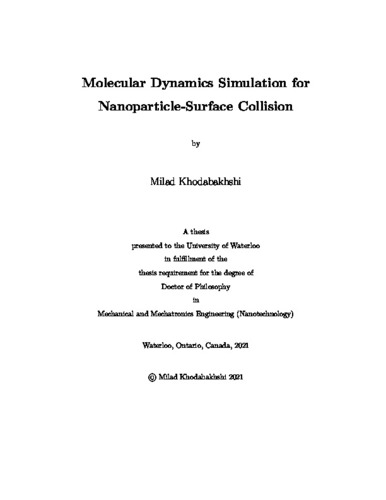UWSpace will be migrating to a new version of its software from July 29th to August 1st. UWSpace will be offline for all UW community members during this time.
Molecular Dynamics Simulation for Nanoparticle-Surface Collision
| dc.contributor.author | Khodabakhshi, Milad | |
| dc.date.accessioned | 2021-09-29 13:59:01 (GMT) | |
| dc.date.available | 2021-09-29 13:59:01 (GMT) | |
| dc.date.issued | 2021-09-29 | |
| dc.date.submitted | 2021-09-27 | |
| dc.identifier.uri | http://hdl.handle.net/10012/17574 | |
| dc.description.abstract | Nanoparticles are referred to as those particles with at least one dimension less than 100nm. Their small sizes lead to high surface area to volume ratios, which results in physi-cal and chemical properties different from their respective larger sized particles and bulksubstances. Because of their unique and extraordinary properties, nanoparticles are synthe-sized and used in a wide range of industrial processes such as biomedicine, energy systems,environmental technologies, and water treatment. Meanwhile, these nanoparticles maybecome airborne, inhalable and cause air pollution. Therefore, removal of the dispersednanoparticles from ambient air is essential to protect the public health. The collision ofthese nanoparticles with a surface needs to be addressed in developing such processes.Accordingly, understanding the collision dynamics and associated characteristics betweennanoparticles and substrate surfaces is essential for the design of high-efficiency aerosolnanoparticle filters, as well as fabricating self-assembled nanoparticles, and developing ad-vanced coating technologies, to name a few. Laboratory equipment is inaccurate in quantifying the effects of different parameterson collision properties of nanoparticles with diameters less than 10 nm on solid surfaces.Additionally, it is impractical to describe for the adhesion behavior based on the dynamicequations of the particle motion because of a lack of information on the material properties.Meanwhile, numerical simulation can help provide a better understanding of the effects ofvarious parameters at molecular scales on the nanoparticle-surface collision properties.Among various simulation techniques, molecular dynamics is especially powerful for thestudy of collision of nanoparticles because it allows a user to modify system conditionsthat may not be possible in experiments. The main objective of this thesis is to investigate the effects of various parameters affecting the adhesion of nanoparticles on a solid surface. The effects of nanoparticlesize and relative humidity of the ambient air are examined using molecular dynamicssimulation. Air humidity can intervene in a particle-surface collision by forming a layerof water molecules on the surface. These water molecules act as a buffer layer that alterthe collision condition. In this work, we study the effects of condensed water layer onthe collision of 5-nm silver particles on a silver substrate. The coefficient of restitutionis used to characterize the collision. Results indicate that the effects of air humidity onthe collisional dynamics depend on the water layer thickness and the surface energy ofthe substrate. Air humidity can either increase or decrease the coefficient of restitutionin the studied nanoparticle collisions. For a high surface energy substrate, the coefficientof restitution first increases then decreases by increasing the water layer thickness on thesubstrate when the impact velocity changes from 20 to 500 m/s. For a low surface energysubstrate, the coefficient of restitution decreases because of a condensed water layer onthe substrate at impact velocities less than 300 m/s. For higher impact velocities, thecoefficient of restitution first increases, then decreases, with the condensed water layerthickness. Therefore, the air humidity reduces the adhesion between the nanoparticlesand the substrate for a high surface energy substrate. For a low surface energy substrate,however, air humidity may increase or decrease the adhesion between the nanoparticle andthe substrate, depending on the impact velocity. In addition, the effects of adhesivity of particles to a surface on the nanoparticle-surface collisional dynamics are also investigated by changing the degree of particle-surfaceadhesion strength. Results show that particles accelerate because of the attraction forceapplied by the adhesive surface when the particles enter the interaction range of the surface.As a result, the particle velocity increases from its initial value to a higher impact velocity.However, the acceleration changes inversely with the particle size. A particle smaller than 2 nm in diameter accelerates and results in an impact velocity higher than its yield velocityeven when the initial particle velocity is much lower than the yield velocity. During thecollision, part of the total energy contributes to the plastic deformation of the sub-2nmparticles, reducing the coefficient of restitution (CoR). For a particle larger than 2 nmin diameter, however, the impact velocity remains lower than the yield velocity when theinitial velocity is lower than its yield velocity, resulting in elastic collision. Furthermore,this size dependent behavior of CoR intensifies with increasing adhesivity of the collisionand becomes less significant for lower adhesivity. This work indicates that a sub-2 nmparticle with a velocity lower than the yield velocity can collide the surface in its plasticdeformation regime and adhere to the surface. | en |
| dc.language.iso | en | en |
| dc.publisher | University of Waterloo | en |
| dc.subject | molecular dynamics | en |
| dc.subject | nanoparticle | en |
| dc.subject | collision | en |
| dc.subject | coefficient of restitution | en |
| dc.title | Molecular Dynamics Simulation for Nanoparticle-Surface Collision | en |
| dc.type | Doctoral Thesis | en |
| dc.pending | false | |
| uws-etd.degree.department | Mechanical and Mechatronics Engineering | en |
| uws-etd.degree.discipline | Mechanical Engineering (Nanotechnology) | en |
| uws-etd.degree.grantor | University of Waterloo | en |
| uws-etd.degree | Doctor of Philosophy | en |
| uws-etd.embargo.terms | 0 | en |
| uws.contributor.advisor | Wen, John | |
| uws.contributor.advisor | Tan, Zhongchao | |
| uws.contributor.affiliation1 | Faculty of Engineering | en |
| uws.published.city | Waterloo | en |
| uws.published.country | Canada | en |
| uws.published.province | Ontario | en |
| uws.typeOfResource | Text | en |
| uws.peerReviewStatus | Unreviewed | en |
| uws.scholarLevel | Graduate | en |

